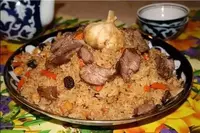The uzbek

Recipes for Uzbek cuisine are known far beyond the borders of the country and this is not surprising, because the eastern dishes in this country are distinguished by a unique aroma and a specific spicy taste. According to a long tradition, Uzbeks prefer lamb, beef from meat, and horse meat is consumed much less often - only a few dishes are prepared from it. As for fish, it is used extremely rarely at all.
Recently, all kinds of dishes from cabbage, potatoes, eggplant and tomatoes have begun to spread quite widely in the cuisine of Uzbekistan. By the way, the use of various spicy herbs and spices is one of the characteristic features of Uzbek cuisine, where zira, coriander, basil, mint, red pepper and other seasonings are mainly added to food.
Soups, which are no less popular here than the same Uzbek pilaf, are cooked over low heat and salted at the end of cooking, since at elevated temperatures, meat fibers harden and nutrients are released into the broth in small quantities, as a result of which the finished dish is tasteless.
It should be noted that Uzbeks are very fond of noodles, which, by the way, are part of numerous first and second courses. So, the soup "Keskan-osh, " a dish called "Suyuk-osh" (noodles seasoned with sour milk and melted butter, with the addition of dried dill), "Naryn" and "Lagman" (boiled noodles with various seasonings) is very popular.
The range of national bakery and confectionery products in this country is also very diverse. The main and one of the most popular types of bread are Uzbek tortillas, which are divided into two categories depending on the components included in them. "Obi-non" is prepared on yeast dough and water, while for the preparation of "Patir-non" you need additional or layered dough with the addition of fat or oil.
Many dishes of Uzbek cuisine are distinguished by a rather complex recipe, and they are prepared exclusively by hand, and this, in turn, requires culinary art and many years of experience. Special professional skill is necessary, for example, when preparing pilaf, which includes not only tens, but also hundreds of kilograms of rice. Dumplings and manti here are molded only with their hands, and a dish called "Sumalyak" should languish on a minimum fire for at least 10 hours.
Whatever you say, and for most people, Uzbek cuisine is primarily associated with pilaf. Interestingly, depending on the area of its preparation, many types of this dish differ, such as Bukhara, Samarkand, Ferghana and others. In addition, the recipes and name of the pilaf may change based on the purpose of this meal and the time of year - for example, ordinary pilaf, festive, winter, summer, spring. By the way, there are more than 100 recipes for Uzbek cuisine for cooking pilaf, but still common to them is the main set of components: rice, meat, carrots, zira and barberry.
If you touch drinks, then the most beloved and widespread can be called green and black tea. They drink green "Coke tea" everywhere (necessarily without sugar) - it quenches thirst perfectly.
 Español
Español Français
Français Português
Português Русский
Русский 简体中文
简体中文 繁體中文
繁體中文 日本語
日本語 한국어
한국어 العربية
العربية Türkçe
Türkçe Қазақ
Қазақ Deutsch
Deutsch Italiano
Italiano Українська
Українська
